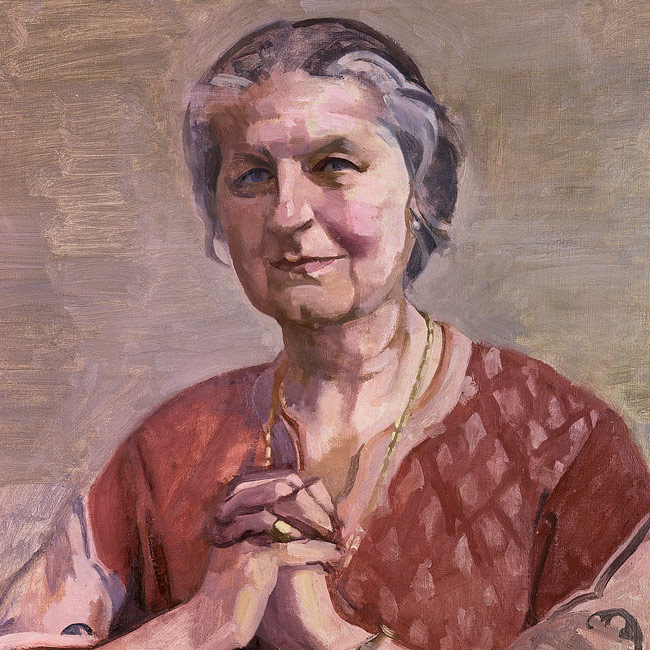A memorial service for the late Professor Anne Crookshank, Fellow of the College, was held in the Chapel on the evening of Thursday 2 March. She died in October of last year in Milford, Co Donegal. Crookshank was the first Professor of the History of Art in the University, and founded the Department of Art History from scratch in 1966, going on to become its first head. Crookshank was a leading figure in developing Irish Art as an academic field, having been appointed Keeper of Art at the Belfast Museum and Art Gallery and finding herself ignorant of many in the paintings in her care. Thus began a life’s work of educating not only herself, but many others, about Irish Art.
Tributes
The packed service was led by the Dean of Residence, the Revd Steve Brunn, and marked Anne’s memory with readings from St John’s Gospel and music by Byrd and Bach marvellously performed by the Chapel Choir. Of the hymns to be sung at her memorial, Professor Crookshank had asked especially for “Abide with Me”, or, as she regarded it, “the one they sing at football matches”; it was duly sung. Dr Edward McParland, a colleague of Professor Crookshank’s in the Art History Department and Pro-Chancellor of the University, paid tribute to his departed friend.
He spoke of her at “home”, that is, in Trinity, and expressed how fondly Crookshank is remembered by many as one of College’s great characters. Born in Belfast, Crookshank came to Trinity in 1945 to read History. Despite having won a scholarship to attend Oxford, her father insisted that Trinity was where their family had always gone to further their studies. There she encountered a changing Trinity, as it was gradually beginning to shed its strict male, Protestant ethos. Still, following her election as a Scholar Crookshank was barred from attending Commons, as it was male-only at the time. She protested this by refusing to dine on Commons for the remainder of her life, even as a Fellow, with perhaps a judicious exception for the odd banquet.
“Committee of taste”
Well-known for her forceful but much-beloved personality, this was recalled in Dr McParland’s tribute as he told fond tales of the so-called “Committee of Taste”: if the “committee” dictated the Senior Common Room (SCR) was to be painted “Withered Rose”, so it would be for many years. But of course, there was no committee: only Professor Crookshank. Her insistence on matters of taste came to the fore after a fire destroyed the Dining Hall in 1984.
The proposal for the refurbished SCR was for white-painted minimalism. Dr Sean Barrett recalled Professor Crookshank vetoing the plan with a dismissive insistence that “Academics are grubby people. They spill things. They bump into people. Their fingers get grubby from reading newspapers. They need their own common room back”. When Dr Webb voiced agreement, encouraging that the refurbished SCR resemble a gentlemen’s club, there was a great cry of outrage from Professor Crookshank. Her influence saw the SCR restored to its former glory.
She led her department ably and established high academic standards despite exercising little formal control over her lecturers except one rule: that they must not be boring. Her enthusiasm and depth of knowledge were well remembered and transmitted and she took her students on many trips to the see the works she lectured on.
She worked in the Courtland Institute, the Tate Modern, the Ulster Museum, and on the Rosc projects. She was a founding member of the Irish Georgian Society and an academician of many others. Her major work was research on Irish painters with the Knight of Glin: in a tempestuous but good-natured and productive partnership they produced three volumes known for both their scholarship and wit over the course of 20 years. They rejuvenated a neglected part of Irish history, challenging the idea that Ireland was famous only for its prose and poetry.
She despaired of the popular neglect of Irish art, saying that “the Irish people suffer from a sense of inferiority about works of art and architecture produced in their own country”. Indeed, a notable episode was her castigation of the Irish government’s decision to take down the statue of Queen Victoria, sculpted by John Hughes, outside Leinster House, sending most of it to Australia but discarding the plinth and surrounding sculpture. Incensed, she wrote: “The IRA blows up our statues, our ecclesiastical authorities vandalise our churches and now our government throws out works of art. We miserable citizens of Ireland seem to have no redress”. Her ferocity was marshalled for causes outside art in her many years campaigning against South African apartheid.







